Filtering in Blazor ComboBox Component
4 Nov 202524 minutes to read
The ComboBox has built-in support to filter data items when AllowFiltering is enabled. The filter operation starts as soon as characters are typed in the input. The default value of AllowFiltering is false.
Local data
The following code demonstrates the filtering functionality with local data in the ComboBox component.
@using Syncfusion.Blazor.DropDowns
<SfComboBox TValue="string" TItem="Country" Placeholder="Select a country" AllowFiltering="true" DataSource="@Countries" Width="300px">
<ComboBoxFieldSettings Text="Name" Value="Code"></ComboBoxFieldSettings>
</SfComboBox>
@code{
public class Country
{
public string Name { get; set; }
public string Code { get; set; }
}
private List<Country> Countries = new List<Country>
{
new Country() { Name = "Australia", Code = "AU" },
new Country() { Name = "Bermuda", Code = "BM" },
new Country() { Name = "Canada", Code = "CA" },
new Country() { Name = "Cameroon", Code = "CM" },
new Country() { Name = "Denmark", Code = "DK" },
new Country() { Name = "France", Code = "FR" },
new Country() { Name = "Finland", Code = "FI" },
new Country() { Name = "Germany", Code = "DE" },
new Country() { Name = "Greenland", Code = "GL" },
new Country() { Name = "Hong Kong", Code = "HK" },
new Country() { Name = "India", Code = "IN" },
new Country() { Name = "Italy", Code = "IT" },
new Country() { Name = "Japan", Code = "JP" },
new Country() { Name = "Mexico", Code = "MX" },
new Country() { Name = "Norway", Code = "NO" },
new Country() { Name = "Poland", Code = "PL" },
new Country() { Name = "Switzerland", Code = "CH" },
new Country() { Name = "United Kingdom", Code = "GB" },
new Country() { Name = "United States", Code = "US" },
};
}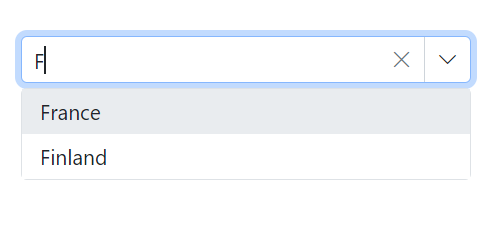
Remote data
For remote data, each key press sends a filter request to the server when using DataManager with filtering enabled.
The below code demonstrates the filtering functionality with ODataAdaptor in the ComboBox component with help of Query property.
@using Syncfusion.Blazor.DropDowns
@using Syncfusion.Blazor.Data
<SfComboBox TValue="string" TItem="OrderDetails" PopupHeight="230px" Placeholder="Select a name" Query="@RemoteDataQuery" AllowFiltering=true Width="300px">
<SfDataManager Url="https://blazor.syncfusion.com/services/production/api/Orders" CrossDomain="true" Adaptor="Syncfusion.Blazor.Adaptors.WebApiAdaptor"/>
<ComboBoxFieldSettings Text="CustomerID" Value="CustomerID"/>
</SfComboBox>
@code{
public Query RemoteDataQuery = new Query().Select(new List<string> { "CustomerID" }).Take(6).RequiresCount();
public class OrderDetails
{
public int? OrderID { get; set; }
public string CustomerID { get; set; }
public int? EmployeeID { get; set; }
public double? Freight { get; set; }
public string ShipCity { get; set; }
public bool Verified { get; set; }
public DateTime? OrderDate { get; set; }
public string ShipName { get; set; }
public string ShipCountry { get; set; }
public DateTime? ShippedDate { get; set; }
public string ShipAddress { get; set; }
}
}Debounce delay
Use the DebounceDelay property for filtering, enabling you to set a delay in milliseconds. This functionality helps reduce the frequency of filtering as you type, enhancing performance and responsiveness for a smoother user experience.By default, a DebounceDelay of 300ms is set. If you wish to disable this feature entirely, you can set it to 0ms.
@using Syncfusion.Blazor.Inputs
@using Syncfusion.Blazor.DropDowns
<label class="example-label">Select a country</label>
<SfComboBox TValue="string" TItem="Countries" DebounceDelay="@NumericValue" Placeholder="e.g. Australia" AllowFiltering="true" DataSource="@Country">
<ComboBoxFieldSettings Text="Name" Value="Code" />
</SfComboBox>
<label class="example-label">Debounce Delay : </label>
<SfNumericTextBox Width="50%" TValue="int" Format="n0" @bind-Value="@NumericValue" Min=1></SfNumericTextBox>
@code{
private int NumericValue = 300;
public class Countries
{
public string Name { get; set; }
public string Code { get; set; }
}
private List<Countries> Country = new List<Countries>
{
new Countries() { Name = "Australia", Code = "AU" },
new Countries() { Name = "Bermuda", Code = "BM" },
new Countries() { Name = "Canada", Code = "CA" },
new Countries() { Name = "Cameroon", Code = "CM" },
new Countries() { Name = "Denmark", Code = "DK" },
new Countries() { Name = "France", Code = "FR" },
new Countries() { Name = "Finland", Code = "FI" },
new Countries() { Name = "Germany", Code = "DE" },
new Countries() { Name = "Greenland", Code = "GL" },
new Countries() { Name = "Hong Kong", Code = "HK" },
new Countries() { Name = "India", Code = "IN" },
new Countries() { Name = "Italy", Code = "IT" },
new Countries() { Name = "Japan", Code = "JP" },
new Countries() { Name = "Mexico", Code = "MX" },
new Countries() { Name = "Norway", Code = "NO" },
new Countries() { Name = "Poland", Code = "PL" },
new Countries() { Name = "Switzerland", Code = "CH" },
new Countries() { Name = "United Kingdom", Code = "GB" },
new Countries() { Name = "United States", Code = "US" }
};
}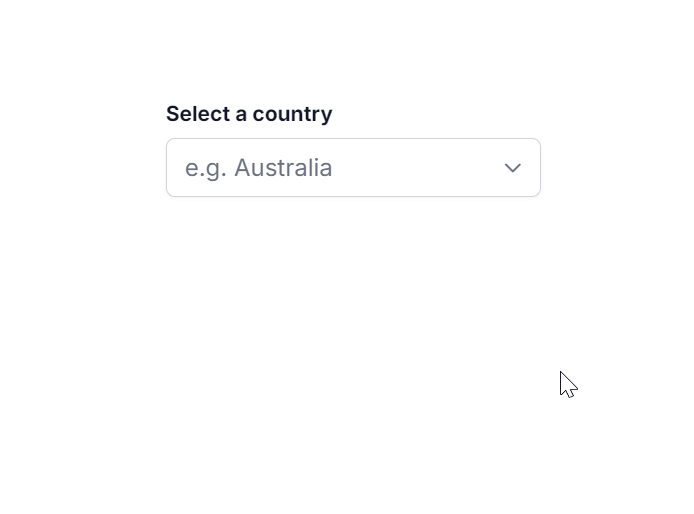
Filter type
Use the FilterType property to specify the string matching mode used during search. The available FilterType options and their descriptions are:
| FilterType | Description |
|---|---|
| StartsWith | Checks whether a value begins with the specified value. |
| EndsWith | Checks whether a value ends with the specified value. |
| Contains | Checks whether a value contains the specified value. |
In the following example, EndsWith filter type has been mapped to the FilterType property.
@using Syncfusion.Blazor.DropDowns
@using Syncfusion.Blazor.Inputs
<SfComboBox TValue="string" TItem="Games" Width="300px" FilterType="FilterType.EndsWith" AllowFiltering=true Placeholder="Select a game" DataSource="@LocalData">
<ComboBoxFieldSettings Value="ID" Text="Game"></ComboBoxFieldSettings>
</SfComboBox>
@code{
public class Games
{
public string ID { get; set; }
public string Game { get; set; }
}
List<Games> LocalData = new List<Games> {
new Games() { ID= "Game1", Game= "American Football" },
new Games() { ID= "Game2", Game= "Badminton" },
new Games() { ID= "Game3", Game= "Basketball" },
new Games() { ID= "Game4", Game= "Cricket" },
new Games() { ID= "Game5", Game= "Football" },
new Games() { ID= "Game6", Game= "Golf" },
new Games() { ID= "Game7", Game= "Hockey" },
new Games() { ID= "Game8", Game= "Rugby"},
new Games() { ID= "Game9", Game= "Snooker" },
};
}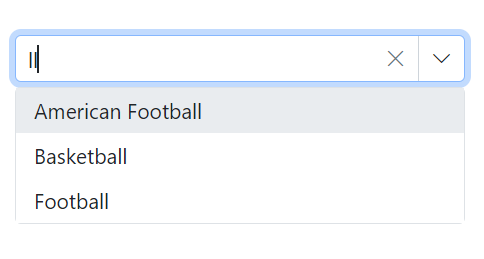
Minimum filter length
When filtering the list items, you can set the limit for character count to raise a remote request and fetch filtered data on the DropDownList. This can be done by manual validation by using the Filtering event arguments within the Filtering event handler.
In the following example, the remote request does not fetch the search data until the search key contains three characters.
@using Syncfusion.Blazor.Data
@using Syncfusion.Blazor.DropDowns
<SfComboBox TValue="string" @ref="comboObj" TItem="Country" Placeholder="e.g. Australia" DataSource="country" AllowFiltering="true">
<ComboBoxFieldSettings Text="Name" Value="Code"></ComboBoxFieldSettings>
<ComboBoxEvents TValue="string" TItem="Country" Filtering="OnFilter"></ComboBoxEvents>
</SfComboBox>
@code {
SfComboBox<string, Country> comboObj { get; set; }
public class Country
{
public string Name { get; set; }
public string Code { get; set; }
}
List<Country> country = new List<Country>
{
new Country() { Name = "Australia", Code = "AU" },
new Country() { Name = "Bermuda", Code = "BM" },
new Country() { Name = "Canada", Code = "CA" },
new Country() { Name = "Cameroon", Code = "CM" },
new Country() { Name = "Denmark", Code = "DK" }
};
private async Task OnFilter(FilteringEventArgs args)
{
args.PreventDefaultAction = true;
// load overall data when search key empty.
if (args.Text == "") await comboObj.FilterAsync(comboObj.DataSource);
// restrict the remote request until search key contains 3 characters.
else if (args.Text.Length < 3) { return; }
else
{
var query = new Query().Where(new WhereFilter() { Field = "Name", value = args.Text, Operator = "contains", IgnoreAccent = true, IgnoreCase = true });
query = !string.IsNullOrEmpty(args.Text) ? query : new Query();
await comboObj.FilterAsync(comboObj.DataSource, query);
}
}
}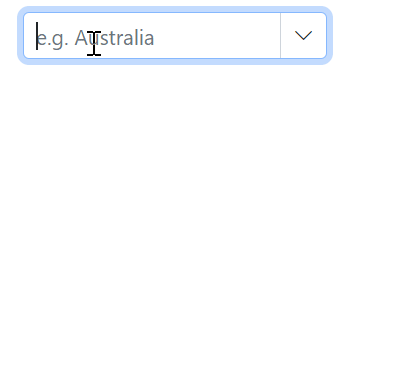
Multi column filtering
In the built-in Syncfusion® Blazor theme files, support for multi column layout can be enabled by adding the e-multi-column class to the CssClass property.
@using Syncfusion.Blazor.DropDowns
<SfComboBox TValue="string" Width="300px" TItem="Countries" Placeholder="e.g. Australia" PopupHeight="200px" CssClass="e-multi-column" DataSource="@Country" AllowFiltering="true">
<ComboBoxFieldSettings Value="Code" Text="Name"></ComboBoxFieldSettings>
<ComboBoxTemplates TItem="Countries">
<HeaderTemplate>
<table><tr><th>Name</th><th>Position</th></tr></table>
</HeaderTemplate>
<ItemTemplate>
<table>
<tbody>
<tr>
<td>@((context as Countries).Name)</td>
<td>@((context as Countries).Job)</td>
</tr>
</tbody>
</table>
</ItemTemplate>
</ComboBoxTemplates>
</SfComboBox>
@code {
public class Countries
{
public string Name { get; set; }
public string Code { get; set; }
public string Job { get; set; }
}
List<Countries> Country = new List<Countries>
{
new Countries() { Name = "Australia", Code = "AU",Job= "Team Lead" },
new Countries() { Name = "Bermuda", Code = "BM",Job="Developer" },
new Countries() { Name = "Canada", Code = "CA",Job="CEO" },
new Countries() { Name = "Cameroon", Code = "CM" ,Job="HR" },
new Countries() { Name = "Denmark", Code = "DK",Job="Product Manager" },
new Countries() { Name = "France", Code = "FR",Job="Developer" },
new Countries() { Name = "Finland", Code = "FI",Job="Team Lead" },
new Countries() { Name = "Germany", Code = "DE",Job="Product Manager" },
new Countries() { Name = "Greenland", Code = "GL",Job="Developer" },
new Countries() { Name = "Hong Kong", Code = "HK",Job="CEO" },
new Countries() { Name = "India", Code = "IN",Job="HR" },
new Countries() { Name = "Italy", Code = "IT",Job="Team Lead" },
new Countries() { Name = "Japan", Code = "JP",Job="Developer" },
new Countries() { Name = "Mexico", Code = "MX",Job="Product Manager" },
new Countries() { Name = "Norway", Code = "NO",Job="HR" },
new Countries() { Name = "Poland", Code = "PL",Job="Team Lead" },
new Countries() { Name = "Switzerland", Code = "CH",Job="Product Manager" },
new Countries() { Name = "United Kingdom", Code = "GB",Job="CEO" },
new Countries() { Name = "United States", Code = "US",Job="Developer" },
};
}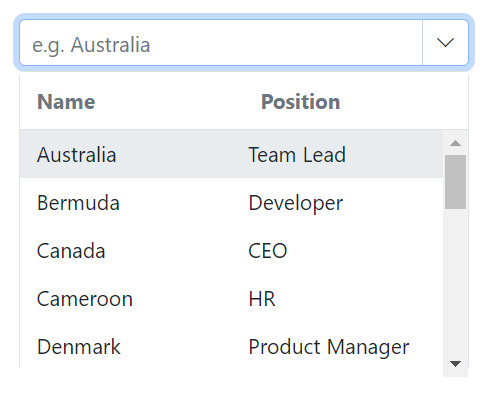
Achieve multiple column(field) filtering by passing the list of predicates to the And or Or methods of WhereFilters.
@using Syncfusion.Blazor.DropDowns
@using Syncfusion.Blazor.Data
@using System.IO
<SfComboBox @ref="comboObj" AllowFiltering="true" TValue="Moc" TItem="Moc" DataSource="@data" CssClass="e-multi-column">
<ComboBoxFieldSettings Text="Text" Value="ID"></ComboBoxFieldSettings>
<ComboBoxEvents Filtering="OnFiltering" TValue="Moc" TItem="Moc"></ComboBoxEvents>
<ComboBoxTemplates TItem="Moc">
<HeaderTemplate>
<table><tr><th>ID</th><th>Text</th></tr></table>
</HeaderTemplate>
<ItemTemplate Context="itemContext">
<table>
<tbody>
<tr>
@if (!string.IsNullOrEmpty((itemContext as Moc).ID))
{
<td><span>@((itemContext as Moc).ID)</span></td>
<td><span>@((itemContext as Moc).Text)</span></td>
}
</tr>
</tbody>
</table>
</ItemTemplate>
</ComboBoxTemplates>
</SfComboBox>
@code {
SfComboBox<Moc, Moc> comboObj;
public Query query { get; set; }
public class Moc
{
public string ID { get; set; }
public string Text { get; set; }
}
List<Moc> data = new List<Moc>
{
new Moc() { ID= "12H", Text= "American Football" },
new Moc() { ID= "14G", Text= "Badminton" },
new Moc() { ID= "17F", Text= "Basketball" }
};
public async Task OnFiltering(FilteringEventArgs args)
{
args.PreventDefaultAction = true;
var orWhere = WhereFilter.Or(new List<WhereFilter> {
new WhereFilter() { Field = "Text", Operator = "contains", value = args.Text, IgnoreCase = true },
new WhereFilter() { Field = "ID", Operator = "contains", value = args.Text, IgnoreCase = true }
});
var query = new Query().Where(orWhere);
query = !string.IsNullOrEmpty(args.Text) ? query : new Query();
await comboObj.FilterAsync(data, query);
}
}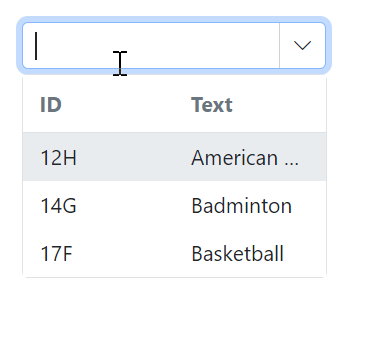
Case sensitive filtering
The data items can be filtered with or without case sensitivity using the DataManager. This can be done by passing the fourth optional parameter IgnoreCase of the Where clause.
The following example shows how to perform case-sensitive filtering.
@using Syncfusion.Blazor.Data
@using Syncfusion.Blazor.DropDowns
<SfComboBox TValue="string" @ref="comboObj" TItem="Country" Placeholder="e.g. Australia" DataSource="country" AllowFiltering="true">
<ComboBoxFieldSettings Text="Name" Value="Code"></ComboBoxFieldSettings>
<ComboBoxEvents TValue="string" TItem="Country" Filtering="OnFilter"></ComboBoxEvents>
</SfComboBox>
@code {
SfComboBox<string, Country> comboObj { get; set; }
public class Country
{
public string Name { get; set; }
public string Code { get; set; }
}
List<Country> country = new List<Country>
{
new Country() { Name = "Australia", Code = "AU" },
new Country() { Name = "Bermuda", Code = "BM" },
new Country() { Name = "Canada", Code = "CA" },
new Country() { Name = "Cameroon", Code = "CM" },
new Country() { Name = "Denmark", Code = "DK" }
};
private async Task OnFilter(FilteringEventArgs args)
{
args.PreventDefaultAction = true;
var query = new Query().Where(new WhereFilter() { Field = "Name", Operator = "contains", value = args.Text, IgnoreCase = true });
query = !string.IsNullOrEmpty(args.Text) ? query : new Query();
await comboObj.FilterAsync(country, query);
}
}Custom filtering
ComboBox component filter queries can be customized using the Filtering event. You can also filter text across multiple columns in the data source by composing predicates.
In the below sample demonstration, the data is filtered using its FirstName or LastName field. Hence in the Filtering event, Predicate is used with or condition for filtering both fields.
For instance, the data source item consists of FirstName as Nancy and LastName as Davalio. You can filter the data by typing N or D, and it will display Nancy (FirstName field) in the popup.
@using Syncfusion.Blazor.Data
<SfComboBox TValue="string" @ref="comboObj" TItem="Country" Placeholder="e.g. Australia" DataSource="@Countries" AllowFiltering="true">
<ComboBoxFieldSettings Text="Name" Value="Code"></ComboBoxFieldSettings>
<ComboBoxEvents TValue="string" TItem="Country" Filtering="OnFilter"></ComboBoxEvents>
</SfComboBox>
@code {
SfComboBox<string, Country> comboObj { get; set; }
public class Country
{
public string Name { get; set; }
public string Code { get; set; }
}
List<Country> Countries = new List<Country>
{
new Country() { Name = "Australia", Code = "AU" },
new Country() { Name = "Bermuda", Code = "BM" },
new Country() { Name = "Canada", Code = "CA" },
new Country() { Name = "Cameroon", Code = "CM" },
new Country() { Name = "Denmark", Code = "DK" }
};
List<Country> CountriesFiltered = new List<Country>
{
new Country() { Name = "France", Code = "FR" },
new Country() { Name = "Finland", Code = "FI" },
new Country() { Name = "Germany", Code = "DE" },
new Country() { Name = "Greenland", Code = "GL" }
};
private async Task OnFilter(FilteringEventArgs args)
{
args.PreventDefaultAction = true;
var query = new Query().Where(new WhereFilter() { Field = "Name", Operator = "contains", value = args.Text, IgnoreCase = true });
query = !string.IsNullOrEmpty(args.Text) ? query : new Query();
await comboObj.FilterAsync(CountriesFiltered, query);
}
}Prevent popup opening when filtering
To prevent the ComboBox dropdown from opening when filtering is applied, use the BeforeOpenEventArgs.Cancel argument in the BeforeOpenEventArgs. Set it to true to cancel the dropdown opening, or false to allow the dropdown to open.
In the following example, the isTyped flag is used to track whether the filtering action is taking place. The OnFiltering method sets the flag to true when the filtering action starts, and the OnBeforeOpen method cancels the dropdown opening if the flag is set to true. Finally, the OnBeforeOpen method resets the flag to false to prepare for the next filtering action.
This prevents the ComboBox dropdown from opening when filtering is applied, while still allowing the user to filter the items using the input field in the ComboBox.
@using Syncfusion.Blazor.DropDowns;
<SfComboBox ID="combobox" TValue="string" TItem="GameFields" AllowFiltering="true" PopupHeight="230px" Placeholder="Select a game" DataSource="@Games" Width="300px">
<ComboBoxFieldSettings Text="Text" Value="ID"></ComboBoxFieldSettings>
<ComboBoxEvents TValue="string" TItem="GameFields" OnOpen="OnOpen" Filtering="OnFilter"></ComboBoxEvents>
</SfComboBox>
@code{
public class GameFields
{
public string ID { get; set; }
public string Text { get; set; }
}
public List<GameFields> Games = new List<GameFields>() {
new GameFields(){ ID= "Game1", Text= "American Football" },
new GameFields(){ ID= "Game2", Text= "Badminton" },
new GameFields(){ ID= "Game3", Text= "Basketball" },
new GameFields(){ ID= "Game4", Text= "Cricket" },
new GameFields(){ ID= "Game5", Text= "Football" },
new GameFields(){ ID= "Game6", Text= "Golf" },
new GameFields(){ ID= "Game7", Text= "Hockey" },
new GameFields(){ ID= "Game8", Text= "Rugby"},
new GameFields(){ ID= "Game9", Text= "Snooker" },
new GameFields(){ ID= "Game10",Text= "Tennis"}
};
public bool isTyped { get; set; } = false;
public async Task OnOpen(BeforeOpenEventArgs args)
{
if (this.isTyped)
{
args.Cancel = true;
} else
{
args.Cancel = false;
}
this.isTyped = false;
}
public void OnFilter(FilteringEventArgs args)
{
this.isTyped = true;
}
}